Demands
Heat (and Process Heat), Electricity and Cooling demands can be specified within energyPRO. An unlimited number of demands can be specified, and in any detail.
Further, you can specify fuel demand. Please refer to Reference, Conversion Units, Fuel Demand for more information.
Demands are added by clicking “Demands” on the left-hand vertical menu and selecting a demand type from the tab that appears above. Additionally, this can also be achieved by right-clicking in the Graphical User Mode’s editing window, selecting “Add” and choose “Demand”.
All the demands will be summarized before the energy calculation. This gives you an opportunity to make a detailed description of the heat demand. But note that detail costs in calculation time. The more demands and the more details the longer calculation time.
When specifying a demand, the first question to be answered is whether the demand is a fixed amount to be distributed in time or a calculated demand. The second question is whether the demand is dependent of external conditions. An extern condition would normally be a time series holding ambient temperatures.

Note that all demands can be converted into a time series representation by pressing the time series button. After this conversion the user has the option to modify this time series as with external conditions.
Demand do NOT depend on external conditions
In its most simple form, a demand is just one single value covering the annual demand or the independent power demand in MW.
Demand is fixed
As shown below, the only number specified is the annual demand of 3000 MWh.. The demand will then be distributed evenly all over the year, taking into account the number of days in the months. The resulting monthly amounts are shown in the “Monthly amounts”-table in the bottom of the window. Note that you have the opportunity to type in and/or change the monthly amounts in that table.
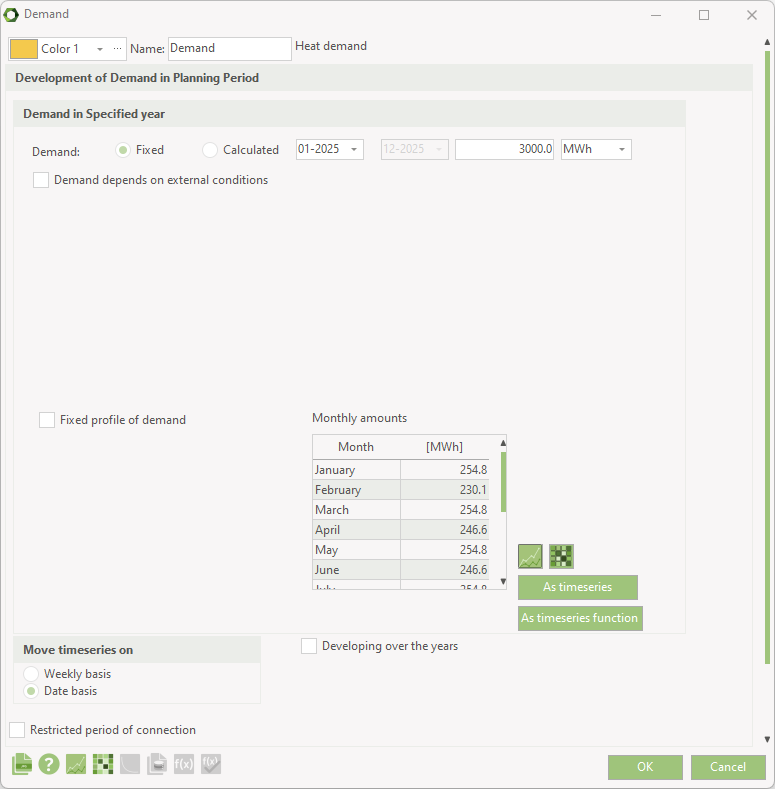
There are several opportunities to design a demand in a way that it reflect daily, weekly, monthly, and annual variations (see later).
Demand is calculated
In this case the only number to be specified is the independent demand in MW. In this case the annual demand input field is dimmed and show the calculated annual demand in the figure below 3000 MWh.
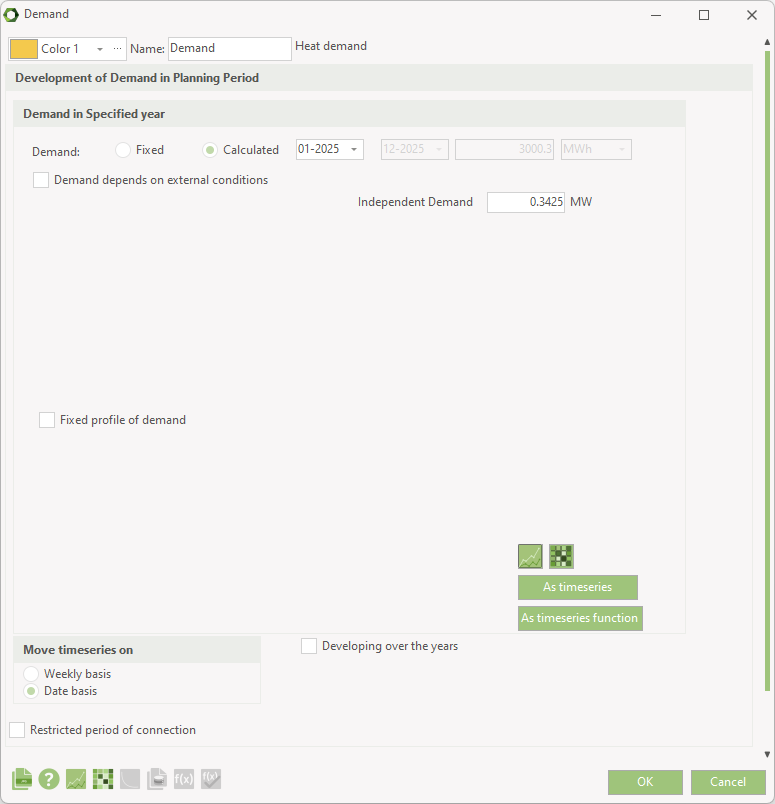
The graphic buttons give access to view your input graphically. Correspondently, the button “As time series” shows the input converted into a time series.
Demand depends on external conditions
Often the demands or parts hereof are dependent on external conditions, most often ambient temperatures. If “Demand depends on external conditions” is marked, a set of options to set will appear. This is shown below. The options consist of three parts.
- Dependent fraction/dependent demand
- Season for dependent demand
- Formula for dependency
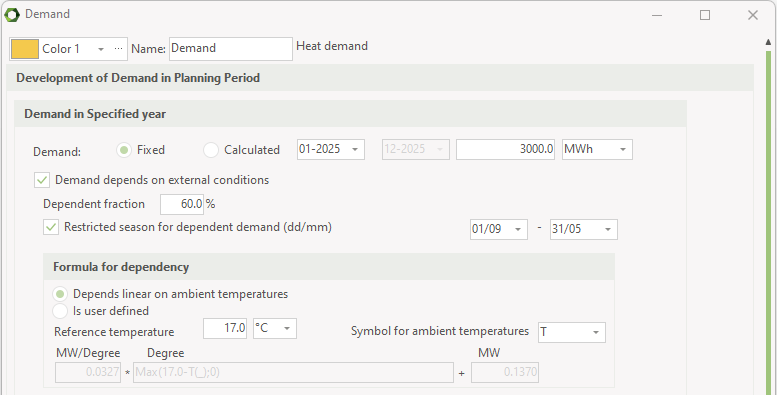
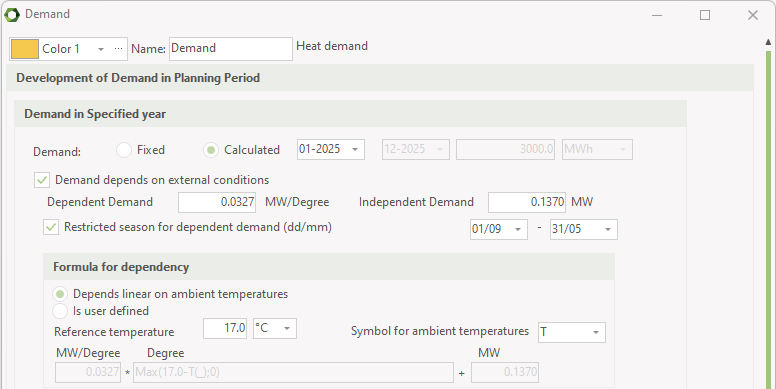
“Demand depends on external conditions” is marked by default when a Heat demand is created but unmarked when other demand types are created.
IMPORTANT: The use of “Demand depends on external conditions” requires that a time series or a time series function containing the external conditions have been established. The time series is normally a time series containing the average ambient temperature day by day during a year.
Dependent fraction /dependent demand
Fixed demand: First, you have to define the fraction of the demand that is weather dependent. In a district heating system for instance 20 % of the heat might be assumed to be heat losses because of transmission and distribution pipes and another 20 % to be used for domestic hot water, leaving 60 % for space heating. These 60 % normally depend on the ambient temperature.
Calculated demand: If calculated demand is selected then a part dependent on external conditions (in MW/unit) and a constant part have to be specified (in MW). In this case the annual demand input field is dimmed and show the calculated annual demand as shown in the figure above lower part is 12000 MWh.
Restricted Season for dependent demand
You have the option to define the “Restricted season for dependent demand” by typing in the first date of the restricted season followed by the last day of the heating season, see above.
Formula for dependency
There are two ways of defining formula for dependency. The first option is that the demand “Depends linear on ambient temperature”. The second option is choosing “Is user defined”.
Depends on linear ambient temperature
Demands are distributed after a simple degree-day method. The reference temperature and a time series containing ambient temperatures have to be typed in or chosen. Based hereupon a formula is auto-generated. In the figure below, the user has chosen \(17°C\) as reference temperature and chosen the time series with the symbol “Dir_DRY_6065”.

Symbol for ambient temperature. In the symbol for ambient temperature combo-box, you find all the symbols attached to the time series and time series functions included in the “External conditions”-folder. Select the symbol used in the time series containing your ambient temperatures, in the figure “Dir_DRY_6065”.
Reference temperature. The reference temperature is the ambient temperature below which room heating is needed. In Denmark, this temperature is normally assumed to be \(17°C\).
Formula. When “Depend linear on ambient temperatures” is chosen the formula field is dimmed and not editable. In the formula field, you see the degree-day formula, including the reference temperature and the symbol for the ambient temperature. The whole formula expression consists of three parts. First part is a factor to be multiplied with the degree-day formula (part two) and finally the constant part. If fixed demand is chosen the first and third part is calculated. If the demand is specified the first and third part of the formula expression is taken from the values stated above (as dependent demand and independent demand).
Short explanation of the used degree-day method. If e.g. the reference temperature is \(17°C\), with an ambient temperature one day on \(12°C\) and another day an average temperature on \(7°C\), there will be \(17°C\)-\(12°C\)=5 degree days in the first day and \(17°C\)-\(7°C\)=10 degree days in the second day. That means that the first day only gets half of the amount of ambient dependent heat demand as the second day.
Is user defined
If “Is user defined” is chosen the options for setting the reference temperature and the ambient temperature is no longer available.

The only option is to define the formula. In the formula shown in above is shown a degree-dependent formula, assuming Dir_DRY_6065 is the symbol for a Time series holding ambient temperatures. In Functions you find a detailed description of the functions to be used in energyPRO.
Fixed profile of demand
Demands do often vary systematically on daily or weekly basis. Checking “Fixed profile demand” and marking one of the two radio-buttons “Daily” or “Weekly” enables options for modelling this. Below is shown an example, where weekly is chosen.
A fixed profile of demand consists of a number of rows each described by a time and a ratio.
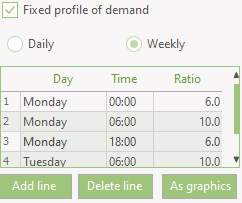
You can add and delete lines by pressing the “Add line” and “Delete line” buttons. If you choose the “As graphics” button, you will see a graphical representation of your time cycle. Below shows an example of the variation of a weekly cycle.
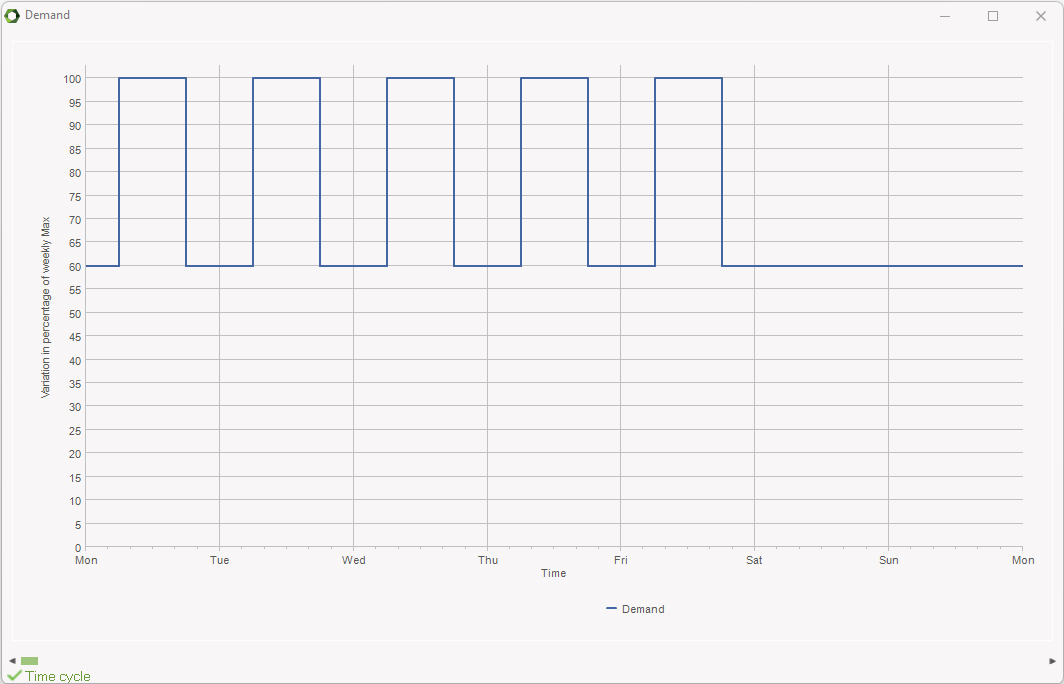
Note that this graphic only shows the variation of the time cycle and NOT the variation of the demand.
Developing over the years
It is possible to design a demand that is developing over the years, see figure below. This is done by marking the field “Developing over the years”, and link to an already created “Index”. All the Indexes in the “External conditions folder” in your project are available the in the combo box. For further information about creating Indexes please refer to External conditions - Indexes.

Restricted period of connection
Another option is to restrict the period of connection. If you for instance want to model that a new demand will emerge next year you have the opportunity to mark the field “Restricted period of connection” and to type in the period in which the demand is present, see figure below. If the restricted period of connection is not specified it is assumed that the demand is connected in the whole planning period.

As time series – button
After having defined a new demand, you can click "As timeseries". Here the demand specified so far will be converted to a time series. This time series can then be edited as described in the section External conditions - Time series.
Internally within energyPRO all demands are converted to this format, before energy calculations are started.
As time series function – button
Beside having the demand as time series, you can select to define the demand as time series function.
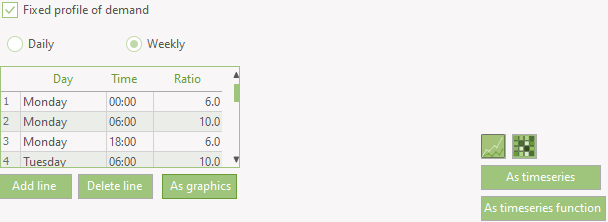
This will give you this window where you can make a function defining the demand. The advantage of using time series function is among others that you can refer to time series covering more years.

Fuel demand
The fuel demand in energyPRO is handled similar to an energy conversion unit. Please refer to Reference, Conversion Units, Fuel Demand.